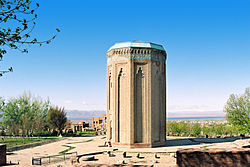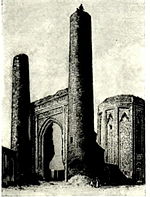- Momine Khatun Mausoleum
-
Momine Khatun Mausoleum
Möminə Xatun Türbəsi
Location Nakhchivan, Azerbaijan Designer Ajami Nakhchivani Type Mausoleum Beginning date 1186 Dedicated to Mu'mine Khatun The Mausoleum of Momine Khatun (or Mu'mine Khatun) is located in Nakhchivan City, the capital of the Nakhchivan Autonomous Republic in Azerbaijan. The mausoleum was most recently restored in 1999-2003, as part of the Azerbaijan Cultural Heritage Support Project of the World Bank, and also depicted on the obverse of the Azerbaijani 50,000 manat banknote of 1996-2006.[1]
Contents
History
It was commissioned by Ildegizid Atabeg Jahan Pahlawan (1175-1186), in honor of his first wife, Mu'mine Khatun, and completed in 1186-1187, as indicated on the Kufic style inscriptive plaque above the entrance. Its architect, Adjemi ibn Abubekr (or Adjemi Nakchivani), also built the nearby mausoleum of Yusuf ibn Kuseyir. Scholars mention that the mausoleum was originally built with a madrassa, and drawings and photographs of the site from the nineteenth century confirm that it existed as part of a religious and educational complex which no longer exists.
Description
The mausoleum is a decagonal brick tomb tower, rising to a height of approximately twenty-five meters. It is built above a crypt and sits on a shallow base made of large blocks of red diorite. A flat roof raised on a tapering, decagonal drum covers the slightly pointed inner dome. The main entrance to the edifice faces east, while a secondary one leads to the crypt, whose vault is supported by a massive central pier.
The solid brick walls of the mausoleum are pierced by two small windows facing West, with an additional window above the main entrance. A band of inscription in Kufic characters composed of turquoise tiles runs below the muqarnas cornice. The recessed surface of its twelve exterior facets are covered with carved geometric motifs on brick, which are highlighted by turquoise tiles, and set in a rectangular frame that includes a small muqarnas crown. Inside, the burial chamber is circular in plan, with bare walls.
The Mausoleum of Mu'mine Khatun is representative of the Nakhchivan architectural tradition of the medieval era, which was heavily influenced by the works of the Azerbaijani architect Adjemi ibn Kuseyir. The Nakhchivani style differed from the Shirvani styles, prevailing in Absheron, in its use of brick as the basic construction material and the use of colored, especially turquoise enameled tiles, for decoration.
Galery
See also
References
- ^ National Bank of Azerbaijan. National currency: 50000 manat. – Retrieved on 24 March 2009.
Sources
- Aslanapa, Oktay (1979). Kirim ve Kuzey Azerbaycan'da Türk Eserleri. Istanbul, Baha Matbaasi, 19, 67-77.
- Ayvazian, Argam (1988). The Historical Monuments of Nakhchivan. Detroit, Wayne State University Press, 90-92.
- Fatullayev, S.S. and R.S. Babasov (2005). "Memarliq". Maison d'Azerbaidjan Website. Accessed November 2, 2005
- Gink, Kalory and Ilona Turanszky (1979). Azerbaijan: Mosques, Turrets, Palaces. Budapest, Corvina Kiado, 29-30.
- Michell, George. Architecture of the Islamic World: Its History and Social Meaning. London, Thames and Hudson, 259. (ed. 1995).
- Azerbaijan Cultural Heritage Support Project. World Bank website.
External links
 Media related to Momine Khatun Mausoleum at Wikimedia Commons
Media related to Momine Khatun Mausoleum at Wikimedia Commons
Coordinates: 39°12′46″N 45°24′20″E / 39.21278°N 45.40556°E
Categories:- Monuments and memorials in Azerbaijan
- Buildings and structures in Azerbaijan
- Nakhchivan
- Visitor attractions in Azerbaijan
Wikimedia Foundation. 2010.



